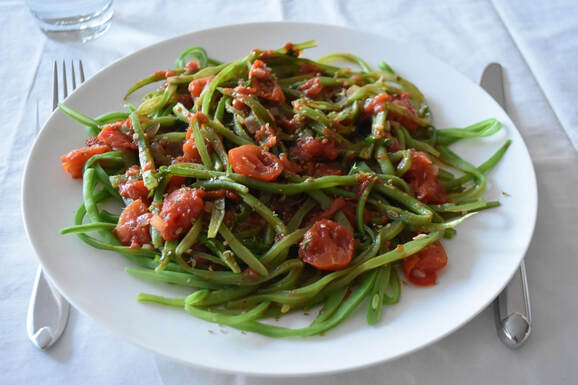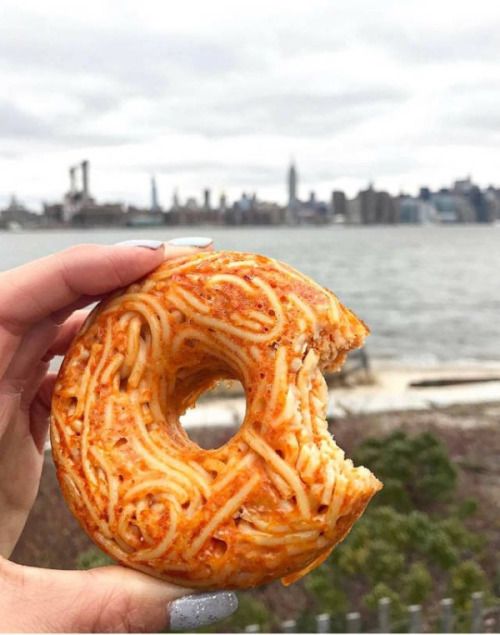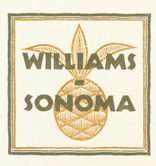|
Without a doubt, one of the best ways to discover truly authentic Italian recipes is to subscribe to Pasta Grammar's YouTube channel. Follow them on social media too... @PastaGrammer. You see, aside from the nonnas on the Pasta Grannies YouTube channel, this raven haired Calabrese, Eva is one of the best cooks who uses traditional techniques for traditional Italian dishes. Her recipe for ciabatta is one you'll want to make every week. --Jerry Finzi ...you throw away your counter-space hogging coffee machine, and now only make your brew in your little silver Moka pot.
I'm not a gullible man. Even as a boy, I wasn't one to believe everything I was told. I always asked questions... "Why? Where? When? How?" I read lots of books, including my entire encyclopedia set and my Atlas. I loved science and the arts. I used both sides of my brain. But as a 12-year-old watching the old Jack Parr show in 1963, I tended to to go by the old adage, "Seeing is believing"--especially if you see it on TV! Big mistake! What I saw was a very legitimate sounding short documentary film with a very scholarly, British voice talking about the spaghetti harvest in Switzerland, and mentioning the "tremendous scale of the Italian's... (harvest)" and the "vast spaghetti plantations in the Po valley". From that point on, until I was in my early twenties, I actually believed there was some sort of special tree or bush in Italy that produced some sort of spaghetti... fruit, pod or otherwise. It wasn't until I saw Jack Parr himself talking about the hoax on the Tonight Show in the early 1970s that I learned the embarrassing truth--a "truth" that I would argue about with my non-Italian friends growing up... "Real Italian spaghetti grows on trees!", I would insist. Parr claimed they didn't get a single call about the segment and most people bought it hook, line and sinker. OK, so maybe I was a bit gullible. But it was a very convincing documentary film, produced originally as a serious film for, of all things, a British news show... and besides, I was only 12! On April 1, 1957, on April Fool's Day (Pesce d'Aprile in Italian), the BBC television show Panorama aired the short "documentary" about the "spaghetti harvest" in Ticino, Switzerland, on the border of the Italian Alps. The film shows spaghetti trees ripe with long strands of spaghetti and a farming family harvesting by hand, putting the spaghetti into baskets and then carefully laying them out to dry in the "warm Alpine sun." Some viewers bought it entirely and called BBC to find out where they could buy some of the "real spaghetti". Many British gardeners wanted to know how to buy a spaghetti bush for their own garden. Others were very angry that a joke was portrayed as a serious subject on a real news program. Still others--like me--just tucked this into their knowledge banks, unquestioningly and carried it as a "truth" through at least part of their lives, being even more convinced every time they heard the expression "fresh pasta"... of course, that must be referring to the real stuff fresh picked from the trees! What did I know. After all, neither my Mother or Grandmother made fresh spaghetti, because spaghetti trees probably didn't grow in our climate. All I ever saw growing up was dried, boxed spaghetti--you know, the fake stuff. The following video is the original broadcast in 1957 in England... The following video gives a behind the scenes take on the Spaghetti Hoax story from a member of the Panorama production team who came up with the idea... The next video shows a further chapter of this hoax broadcast in 1967 in Britain explaining how the spaghetti crop was being ruined by a terrible pest--the spag-worm, or "troglodyte pasta". ("Troglodyte" refers to a person so stupid because he lives in a cave). In 1978, San Giorgio Pasta produced a remake of the Spaghetti Hoax for one of their TV ads. Finally, cooking know-it-all, Martha Stewart (I'm not a fan) got into the act in 2009 with her own little spoof about her Spaghetti Bush, "spago officinalis" ("official string") trees.  Italian snake bean seeds on Amazon Italian snake bean seeds on Amazon Well, I've had a lot more culinary education since being misled by that little April Fool's prank when I was young and impressionable: my Mom and Dad taught with every loving dish they put in front of me; Grandma taught me her authenticity; having home and studio in Manhattan for so many years where varied cuisines are around every corner also taught me; In my 30s, I finally learned how to cook from Julia Child, Craig Clairborne, Marcella Hazan, Mary Ann Esposito and Pierre Franey. I now make fresh pasta with my son, Lucas from time to time. And during our Voyage throughout Italy, I never saw a single strand of spaghetti on a bush, tree or vine. Ever. (OK, so I did look, just to be sure.) However, I have since learned that there are actually spaghetti alternatives that grow from Madre Terra. I even grew 2 foot long "snake" beans a few years ago that came pretty close. Here are a few veggie spaghetti alternatives... If you want to make your own, fresh "veggie spaghetti" at home, pick up a Premium Vegetable Spiralizer from Amazon or the attachment we use for our stand mixer, the Kitchenaid Spiralizer Attachment. It's a lot easier than picking the spaghetti from the trees, collecting in baskets and spreading them out in the sun to dry...
(Damn you, Jack Parr and your dry sense of humor!) --Jerry Finzi The key phrase on these products is "Limoncello INSPIRED creations". Barely lemon flavor. Mostly artificial flavoring. But, really now... cups?
Maybe they're scented. Nope... just the same yellow plastic cups they sell on other shelves. Nothing to see here... pass it by. --GVI  I was shocked when my wife Lisa unpacked the new shipment of wines and saw a boxed wine--Fregi Barocchi's Salento Rosso from Palama Vineyards. I mean, I'm anything but a wine snob, but the few times I've had to swallow boxed wines at friends' homes I wasn't the least bit impressed. But, OK, she had spent the amazingly low sum of $25 for three liters, so I thought I'd give it a quick sniff, swill and spit and while exile the remaining contents to our kitchen sink's drain. But wait a second... (sniff). is that clover I smell? (Sniff... sniff). Is that cinnamon? Apple slices? I could swear I smell honey... and hay... and a touch of rosemary? Now to taste. Surely tasting the stuff is going to prove that this box has been in the heat of a container on a ship for Lord knows how long.... I expected vinegar but what I got was nectar! We've been in love with wines from Puglia ever since we Voyaged there and sampled great wines throughout the region. I don't think we ever had a bad bottle--even cheap, €4 bottles from local alimentari. We loved them so much that we always have a stock on hand (especially Primativo). And they are affordable here in the States, too. I don't think we've ever paid more than $20 for a bottle from Puglia. But a boxed wine... 3 liters for under $25? How can this be SO good!?  The Palamà family vineyard was founded by Arcangelo Palamà in 1936. A family of Greek origins, they settled in Italia about two thousand years ago, and have been making wine ever since. For 70 years had only sold their wine in their restaurant–until Small Vineyards (a specialty wine importer) came knocking on their door. The current winemaker is Ninì Palamà, son of Arcangelo, a larger than life character who will burst into song without notice, a man with a lust for life--and wine. His wines are full-bodied, intense and often spicy, like the Salento Rosso (also available in bottles). His wines capture the climate, sold and everything gown in fertile and dry Puglia. There is also an elegance in his wines that is becoming more and more common with Pugliese wines. Apulia has had a Renaissance or sorts since the post war period. Due to his estate’s proximity to the sea, the value of Southern coastal reds is that they pair as readily with seafood as they will with hearty meats. For us, this amazing boxed masterpiece paired well with pizza, a rich Ragu alla Bolognese and even risotto. We can't recommend this wine highly enough--even though it pours out of a silver Mylar bladder stuffed inside that box. Oh, and if you are a bit of a wine snob, no worry... it's also available it very presentable bottles. --Jerry Finzi --Buy it at Astor Wines OK... now this situation is really starting to get to me--and my stomach. There are many so-called "Italian" pages on FB where members proudly post photos of their "culinary creations" (in the same way that the Monster was Frankenstein's "creation"). I'm getting sick of this. Literally. I've decided to shame these repulsive recipes, these disgusting degustations, these less than amusing-bouches...
Here's one I can't even figure out! (And don't really want to know.) --Jerry Finzi You know, I always thought I'd have a problem eating weird things if I ever traveled in the Orient. I'm a person with a fairly narrow palate... I admit it. Even my 14 year old, Lucas has a much broader palate than I do. I like what I like and won't try what I know I don't like. I'm old enough to say that I have tried lots of stuff--for instance, I hate caviar and cooked spinach makes me gag. I know what I can't stomach. In my research and travels about Italy, I've come across things that I wouldn't eat if you paid me. Some things I'll try--once--while others... well, you just sort of know to stay clear. Still, we have to respect the culinary traditions of our Italian heritage and try not to be so grossed out by it. Food is fuel--fuel is food. In Italy, nothing goes to waste--not beast or flora. So, I hope you pardon me as I poke a little fun at some of Italy's oddest culinary creations--even though I may tease a bit, I still want to honor the complexities if la Cucina Italiana... In ancient Rome peacock eggs, boiled ostrich and stewed parrots were common on menus.  Stuffed Mice There is a protected, fluffy tailed species of dormice (Glis glis or Ghiro) that have been eaten since the days the Caesars ran things. Down in Calabria the rodents are still stuffed and chomped on. They are stuffed with meat, nuts, raisins, onions and spices. You can imagine little squeaks as you take a bite. I have no idea what they do with all those cute fluffy tails. Ghiri alla pizzaiola : Ingredients : . 2 Ghires, 50 g of lard, 50g of pancetta, gr 600 gr peeled tomatoes, 1 tablespoon of chopped parsley, 1 tablespoon of oregano, 1 tablespoon extra virgin olive oil, 1/2 teaspoon of salt Engage the dormice lengthwise, peel them, quickly remove the bladder without breaking it and leave it in running water for a few hours. Rinse them and blanch in boiling water for a couple of minutes. Chop the lard and the bacon and put the mince in the belly of the dormice. Place them in a large pan, pour the oil and cover with chopped tomatoes, parsley and minced garlic, oregano and salt. Cook over moderate heat, keeping the pan tightly closed with the lid.  Riccota Forte (or Scanta) The Pugliese are a resourceful bunch. I know--mu Dad was from Puglia. Many of you may know that ricotta means twice cooked or re-cooked... basically, ricotta is a by-product of normal, everyday cheese making. You take the little bit of whey left over, add an acid, boil it and presto, you have ricotta cheese. It's a fresh cheese and should be eaten within a couple of days. When it dries out, the frugal Pugliese add salt, and let it dry even more into Ricotta Salada (one of my favorite cheeses). But some go even further. Some just let it go bad... and stinky... and acrid, turning it into a Apulian delicacy called Ricotta Forte, or Scanta. Many think this acrid, foul smelling cheese is worse than any other stinky cheese they've even eaten--but in a good way. We tried it during our stay in trullo B&B outside of Alberobello. Yes, it stinks, and our host told us how it's just kept in a dark, un-refrigerated place (under his sink) to grow more bacteria and even sometimes microscopic worms--but we actually liked it! (But it did burn my eyes a tad).  It's the kind of taste that shocks your eyes open, assaults your nose but somehow in the end pleases your palate. It's also a surprise when you are first introduced to it in a plain jar that looks like it's your Aunt's 1950s era home brew face cream. Enjoy. (Oh, just don't get it on anything sweet... I got it on some Nutella and bread by mistake and nearly got whiplash when I popped it in my mouth.)  Casu Marzu or Formaggio Marcio (Rotten Cheese), with Maggots Casu Marzu is a sheeps' milk cheese from Sardinia and Corsica (they call it Casgio Merzu) that actually contains maggots--live ones. Most cheeses rely on fermentation and bacteria to develop their flavor, but this cheese relies on actual decomposition caused by the Cheese Fly larvae. The texture is an oozing, seeping liquid, essentially caused by... well... maggot poop. Some people eat this stuff with the larvae, some will tickle the cheese, causing the larvae to be disturbed enough to actually jump out... as much as 6 inches! The daring who have tasted it say this muck is so acidic that it leaves an after taste in your mouth for hours afterward. I recall a cheese like this in France years ago--I wouldn't go near that either!  Batarga From what I hear, battarga is definitely an acquired taste that's at least a thousand years old and perhaps more ancient than that. It's made from the roe (fish egg) pouch of either grey mullet or Atlantic blue-fin tuna. The roe pouch is manipulated by hand to get rid of any air bubbles and then cured in sea salt for several weeks. After curing, the result is a hard, dried salty slab which is usually (but not always) coated in beeswax.  To use it, you grate some on top of pasta or on top of crostini (toasted bread) and drizzled with olive oil. It also can be used as a main ingredient along with garlic for tomato sauce. It has a tremendously long shelf life and is often smuggled out of Italy due to its high price--up to $140 a pound! You can actually order some on AMAZON.  Colatura di Alici, Fish Sauce In ancient Roman times there was a fishy concoction called garum, a clear sauce made from salting and compression of various types of fish. The clear garum on top was used by the upper classes, while the sludge left over, called allec, was used by the lower classes to add flavor to polenta, porridge or on bread. Today there is a modern version called Colatura di Alici made in one of my favorite villages on the Amalfi Coast, Cetera (click the photo to see it on Amazon). The first time I took a tour of Cetera at ground level on Google Earth I started seeing barrels and wondered why this village had so many. It's a fairly simple recipe... 
The golden liquid is prized in Italy and is used to flavor all sorts of dishes. Watch the video of Colatura being made... 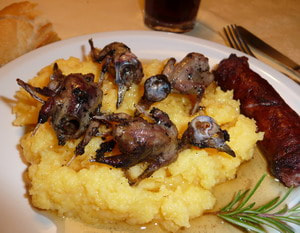 Polenta Uccelli (Polenta with Songbirds, or Polenta e Osei) Yes, the same song birds that will awaken you on a misty Tuscan morning are being shot or captured in hanging nets by hunters to supply their illegal bounty to select restaurants throughout Italy. Yes, it is illegal, but those doing it consider the practice as being furbo (crafty). They make a living while carrying on a tradition. In Tuscany the birds are flambéed, in Sardinia they are boiled and preserved, in the Veneto rolled in pork belly and fried. Perhaps the best known version is in Lombardy where they are grilled or fried. It seems this is an elite recipe item in Italy. Ladies and gents get dressed up in all their finery and make an event out of eating these little skylarks, goldfinches and other types of song birds. Our hot air balloon pilot, Stefano told us they shoot anything in Italy, especially song birds, so much so that some species are becoming endangered. Oddly, we flew directly over some "hunters" in their treetop blind, releasing pigeons only to shoot them a moment or two later. The little tweetys are usually stuffed with pork, beef, rabbit or even other birds. They are served with their heads and beaks on top of polenta, an attempt to mimic a bird's nest.  To illustrate how much Italians love this special dish, certain pasticcerie have created a legal version: a dessert called Polenta e Osei, made to look just like the real dish. It's made of a soft light sponge cake filled with hazelnut cream that is rolled in a yellow fondant. On top are little chocolate birds made from chocolate marzipan. You can find this in the town of Bergamo. As for the real song bird dish, the macho thing is to pick up the birdie by the beak and leave nothing... devouring bones, beak and all. At least they are not as ruthless as a similar dish I saw in France years ago--where they drown the birds in the local brandy, then when eating drape a napkin over their heads and the dish to inhale the fragrances and crunch down on the bird, apparently head hidden in shame.  Pajata (Cheese from Cow's Intestines) This is either a Roman dish or what the Devil himself would order up. A young, milk fed (no grass feed) calf is slaughtered, and besides getting veal, brains and other delicacies from it, the intestines are used to make this delicacy--pajata. The intestines are washed, but not emptied. When cooked, the partially-digested milk inside turns into a thick, funky cheesy substance which is used as a pasta sauce, and often served on its own with crostata. No grazie! 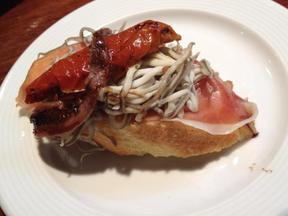 Cieche (Baby eels) Cieche are baby eels that migrate upriver after being born in the sea. The name, Cieche (cieco) literally means blind – these babies have no eyes. In coastal areas of Tuscany, cieche are usually fried or boiled alive. Just be careful they don't jump out when you're trying to dump them into the boiling water or saute pan. 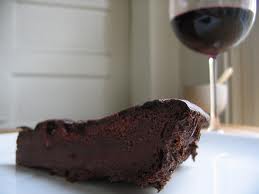 Tuscan Blood Torte Enough said. A torte or cake made from the blood of pigs? I've tried Argentinian blood sausage and British blood sausage, and if the flavor is anything close to what I experienced, I would never go near this stuff. But this recipe contains cocoa and has a chocolate taste, albeit a bit more... er... pungent because of the pig's blood it contains. The pudding used is similar to Sanguinaccio Dolce, a traditional recipe in the South made when a pig is slaughtered using the pig's blood, chocolate, raisins pignoli and sugar. This is an example of the Italian philosophy that nothing goes to waste, not even the last drops of blood. Watch the video below from the Two Greedy Italians series where Gennaro shows how they make the pudding (at 9:45).  Vending Machine Pizza As all of the above proves, Italians will eat anything... even pizza made totally inside a robotic vending machine. Not THAT's a real crime! Let's Pizza machines were initially designed and manufactured in Northern Italy. It offers a choice of four kinds of pies, and makes the pizza while you watch the whole process through windows--adding water to flour, kneading the dough, placing the sauce and toppings, and baking the pizza via infrared oven in just 2.5 minutes. It can produce 90 to 100 pizzas before it needs to be refilled. Ugh. Just because you can, doesn't mean you should!  Ok, so vending machine pizza isn't such a big deal, but how about (suspenseful music...) Gatto in Umido? This translates as "Stewed Cat"! Calmati, Betty White... "Gatto in Umido" is simply Stewed Cat-Fish. As I said, we all have to keep an open mind. I hope you enjoyed this look into the traditions of culinary Italy. Via la Cucina Italiana! --Jerry Finzi |
Archives
May 2024
Categories
All
|






